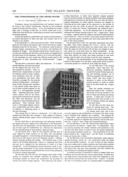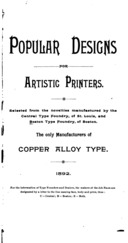Annenberg tells two contradictory stories of the origins of the Central Type Foundry.
In a note in his discussion of the Boston Type Foundry, he discusses a situation at that foundry in the 1860s where one of its principals, John K. Rogers, was for a time forced out. During that period, James A. St. John was appointed to run the business. However, Rogers (Annenberg says) regained control. Rogers then, in 1870, opened a branch office in St. Louis and moved St. John there to manage it. In this version of the story, the St. Louis branch, "not being immediately successful, ... was ordered closed in 1874" (p. 73). At this time, St. John went into partnership with Carl Schraubstadter to purchase the branch and establish it as the Central Type Foundry.
The story in Annenberg's chapter on the Central Type Foundry differs slightly. In this version, the St. Louis branch of the Boston Type Foundry begins in 1872 (still with St. John as its manager) and "business boomed immediately." (p. 98) St. John and Schraubstadter, in this version as in the other, combined to purchase the branch and set it up as the Central Type Foundry in 1874.
The account in Mullen gives yet a third date for the start of the St. Louis branch of the Boston Type Foundry: 1871. However, Mullen's account relies upon Henry Lewis Bullen (specifically, the installment of his "Discursions of a Retired Printer" series in The Inland Printer, Vol. 39, No. 2 (May 1907): 197. Unfortunately, Bullen is a highly unreliable source who at times simply fabricated good stories (which have often been repeated as if they were true). Any information from him must be considered untrustworthy in the absence of independent confirmation.
Mullen's account continues with the backing of much more reliable sources, however (e.g., city directories and contemporary journals). Both it and Annenberg's account describe a very successful type foundry with strong business (St. John) and technical (Schraubstadter) leadership.
In 1888, Schraubstadter and St. John, as individuals, purchased control of the Boston Type Foundry. Mullen describes the way in which these two foundries operated under two names but in close technical and business association (pp. 34-35).

Inland Printer (1890)
Anon. "The Typefoundries of the United States: No. III - The Central Typefoundry, St. Louis." The Inland Printer. Vol. 8, No. 7 (April 1890): 638.
Scanned by me from the original. Here are links to the other articles in this series .
Annenberg writes of the amalgamation of ATF that "... the Central Type Foundry of St. Louis and the Boston Type Foundry were the only two foundries purchased for cash." (p. 73)
The Central Type Foundry has the distinction of having been the first in America to use machine (pantograph engraving) methods in the production of matrices.
In 1882, the foundry purchased a non-Benton matrix engraving pantograph, apparently a German machine that had been imported by the Cincinnati Type Foundry. This machine was used to engrave at least Geometric, Geometric, and Morning Glory. Nicholas J. Werner said that in doing so this foundry was the first one to produce new display faces by the aid of engraving machinery . See also the Notebook on matrix making Beyond (and Before) Benton.
Maurice Annenberg, in Type Foundries of America and their Catalogs. Second Edition. (New Castle, DE: Oak Knoll Press, 1994) says that "Central was the first to introduce new type faces that were manufactured by the aid of engraving machinery, invented by Linn Boyd Benton..." He is correct except insofar as he attributes this machine to Benton, when (see above) it predated him.
We know from the April 1891 Inland Printer article on the Central Typefoundry that at that time it had in its "casting department ... thirty-five machines, including the wonderful Foucher French type-casting and finishing machine." (638).
The Foucher machine is not well known in America. It dates from at least 1879, and the work of Foucher (in France). In 1885, Küstermann in Berlin began production of "System Foucher" machines. These were machines of the style later termed (in the US) "foundry automatics" - substantial machines producing fully finished types, remarkably similar to the later (1888) Barth type casting machine.

1892. Popular Designs for Artistic Printers. [Central & Boston]
Popular Designs for Artistic Printers. [title as it appears on the title page, not the cover] (St. Louis, MO and Boston, MA: Central Type Foundry and Boston Type Foundry, 1892.)
This specimen was produced at a point of great change in the American typefounding industry. The owners of the Central Type Foundry (Schraubstadter and St. John) had purchased the Boston Type Foundry in 1888. This specimen book, a joint effort of the two type foundries, is dated 1892. That is the year in which both companies were sold into the newly formed American Type Founders amalgamation. The bulk of the specimen book itself makes no reference to ATF. However, a final page (which is typographically distinct from the rest) advertises "Original Type Designs" for sale by many of the type foundries which amalgamated into ATF (two of which are noted as "Owned and Operated by the American Type Founders' Company"). On its title page this specimen refers only to the Central and the Boston foundries, but the cover of this particular copy bears the title "Artistic Novelties for Printers, for sale by Boston Type Foundry, Boston." It seems reasonable to conclude that this specimen was prepared jointly by the Central and Boston foundries before the formation of ATF but that this particular copy was published by the Boston Type Foundry after the formation of ATF. Many of the larger foundries which combined into ATF retained separate identities for several years. (Annenberg, in Type Foundries of America and their Catalogs, indicates that the Central did not produce a specimen under the ATF name until 1895.)
This volume has been digitized by Google Books from the University of Michigan copy. The icon at left links to a version of this digitization that I assembled from the higher-resolution page scans available from The Hathi Trust. Here is a local copy of the same: central-boston-1892-hathi-mdp-39015063770823-png.pdf Note that the Hathi page images are scanned at various resolutions, and so when presented literally as they are in this version they appear to be different sizes on screen. It is possible to "normalize" the image so that they all appear to be the same size, but this means that many of the images must be either enlarged or shrunk. The result is easier to read on-screen, but resolution may have been lost. Here is a "normalized" version: central-boston-1892-hathi-mdp-39015063770823-normalized1140x.pdf.
The Hathi Trust version may be accessed directly at: http://hdl.handle.net/2027/mdp.39015063770823.
Here is a local copy of the Google Books digitization as Google presents it, which is lower-resolution (but only 3.8 Megabytes): central-boston-1892-google-mich-popular-designs-for-artistic-printers.pdf.
Regrettably, the underlying Google scan of this volume is poorly (and confusingly) done and much information in it has been lost.
N. J. Werner, in a digression on engraving machines in his article "Wiebking Created Popular Faces in Chicago, Friend Discloses" The Inland Printer Vol. 90, No. 2 (November 1932): 71-73. cites Geometric, Geometric Italic, Morning Glory and "the first typewriter face" [presumably Type Writer [No. 1]] as having been cut by the Central Type Foundry on a non-Benton matrix engraving pantograph.
Werner, N.J. "Saint Louis' Place on the Typefounders' Map." The Inland Printer. Vol. 79, No. 5 (August 1927): 764-766. cites Geometric Geometric Italic and Morning Glory

DeVinne
1893. N. J. Werner, in a digression on engraving machines in his article "Wiebking Created Popular Faces in Chicago, Friend Discloses" The Inland Printer Vol. 90, No. 2 (November 1932): 71-73. cites DeVinne as as one of several faces the matrices of which were engraved by Gustav F. Schroeder using a non-Benton matrix engraving pantograph formerly owned by Central Type Foundry. He cut the face for Central. Werner attributes its design to him as well.

Geometric
Eckman, James. "The Great Western Type Foundry of Barnhart Brothers and Spindler, 1869-1933." Printing and Graphic Arts. Vol. 9 (1961): 1-32 dates Geometric to 1882. Werner, N.J. "Saint Louis' Place on the Typefounders' Map." The Inland Printer. Vol. 79, No. 5 (August 1927): 764-766. cites Geometric as one of several faces the matrices of which were engraved by a non-Benton matrix engraving pantograph at this very early date.

Geometric Italic
Central Type Foundry, St. Louis. Werner, N.J. "Saint Louis' Place on the Typefounders' Map." The Inland Printer. Vol. 79, No. 5 (August 1927): 764-766. cites Geometric Italic as one of several faces the matrices of which were engraved by a non-Benton matrix engraving pantograph at this very early date.

Morning Glory
1882. Werner, N.J. "Saint Louis' Place on the Typefounders' Map." The Inland Printer. Vol. 79, No. 5 (August 1927): 764-766. cites Geometric as one of several faces the matrices of which were engraved by a non-Benton matrix engraving pantograph at this very early date.

Type Writer [No. 1]
[date?] N. J. Werner, in a digression on engraving machines in his article "Wiebking Created Popular Faces in Chicago, Friend Discloses" The Inland Printer Vol. 90, No. 2 (November 1932): 71-73. cites "the first typewriter face" as one of several faces the matrices of which were engraved at Central by a non-Benton matrix engraving pantograph at this very early date. Maurice Annenberg, in Type Foundries of America and their Catalogs. Second Edition. (New Castle, DE: Oak Knoll Press, 1994) says that Central "was the first foundry to introduce typewriter type".

Type Writer No. 2
Reviewed in The American Bookmaker Vol. 10, No. 1 (1890-01): 20-21.
Annenberg, Maurice. Type Foundries of America and their Catalogs. Second Edition. (New Castle, DE: Oak Knoll Press, 1994)
Mullen, Robert A. Recasting a Craft: St. Louis Typefounders Respond to Industrialization . (Carbondale, IL: Southern Illinois University Press, 2005)
All portions of this document not noted otherwise are Copyright © 2011 by David M. MacMillan and Rollande Krandall.
Circuitous Root is a Registered Trademark of David M. MacMillan and Rollande Krandall.
This work is licensed under the Creative Commons "Attribution - ShareAlike" license. See http://creativecommons.org/licenses/by-sa/3.0/ for its terms.
Presented originally by Circuitous Root®
Select Resolution: 0 [other resolutions temporarily disabled due to lack of disk space]